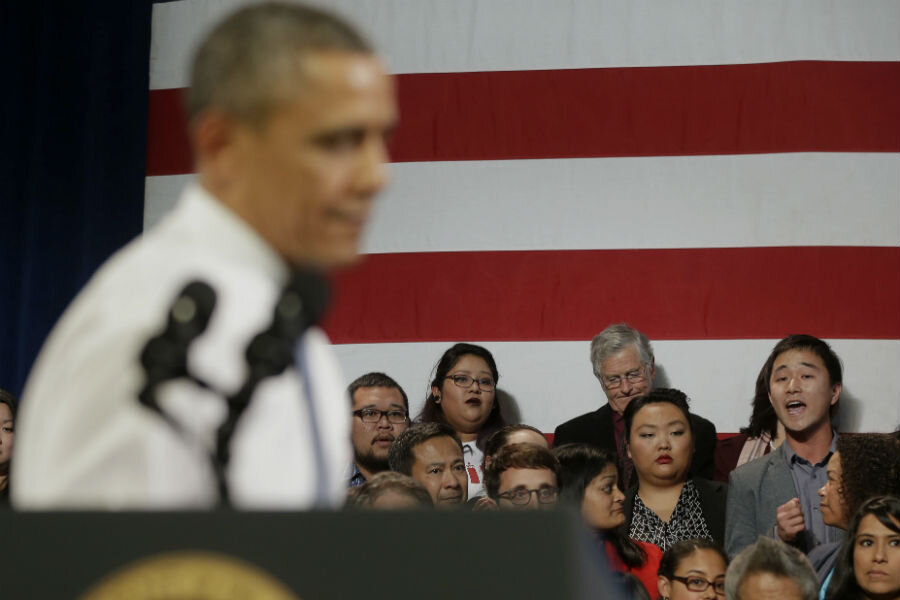How many people has Obama really deported?
Donald Trump is not the sort of candidate that often looks to precedent when defending his proposals. When he does, he sometimes lands on odd examples.
“President Obama has moved millions of people out,” said the Republican nominee on Wednesday night. “Nobody knows about it. Nobody talks about it. But under Obama, millions of people have been moved out of this country. They’ve been deported.”
To be sure, Mr. Trump has pledged to undo the tethers – fixed in place by directives from Mr. Obama – on whom immigration authorities can target for deportation, while promising to triple the number of agents. And the candidate is making enforcement a priority: the changes would take place, he has said, on “day one.”
But Trump was indeed correct when he pointed to the rate of deportations under Obama, which climbed to more than 2.5 million through 2014, the last year of government data and well beyond the total under George W. Bush’s presidency, when deportations first began to spike. If the rate has remained steady since then, says Marie Price, a geography and international affairs professor at George Washington University who studies migration, the total might have reached more than 3 million.
“It’s an inconvenient truth for Republicans and Democrats,” she tells The Christian Science Monitor. For Republicans who argue that little has been done to expel unauthorized immigrants, the figure proves that much has actually been done. For Democrats that prize the Latino vote, she says, “this is an embarrassment.”
That the meaning of the number is interpreted in such divergent ways, though, seems to point to how extensively elaborated distinct ideologies on immigration have become, after a decade and a half of Congressional failures to achieve bipartisan reform. And Obama’s failure to use stepped-up deportations as a means of boxing Republicans into a comprehensive reform could set the terms for future presidents.
“That clearly didn’t work for President Obama, and it caused a lot of grief among his allies,” says Faye Hipsman, a policy analyst at the Migration Policy Institute, a Washington D.C., think tank.
After bipartisan reforms dissolved, Obama turned to executive actions to make more limited, temporary and politically volatile changes, including the Deferred Action for Childhood Arrivals (DACA) program in 2012 and its 2014 sister, DAPA, which a Republican-led legal challenge later blocked.
As The Christian Science Monitor’s Warren Richey wrote in 2014, Obama isn’t the first president to use executive authority to defer immigration enforcement against certain non-citizens – John F. Kennedy, Ronald Reagan, and both Bushes did so, too.
“But unlike Obama,” the Monitor wrote, “each of those presidents was acting with the support of Congress rather than in defiance of congressional leaders.”
Those actions may have laid the groundwork for future executive actions; for many undocumented immigrants, much could hinge on whether the next president wants to revoke previous directives. But two Obama-authored changes in deportation policy, denounced as draconian by immigrant advocates, seem unlikely to fade away.
One is a change in how immigration authorities operate along the border, says Rene Rocha, a political scientist at the University of Iowa and leading expert on the policy and politics of immigration.
Immigration authorities, he tells the Monitor, started placing more formal removal orders against unauthorized immigrants apprehended near the border. That meant that more people would likely make an appearance before a legal entity, rather than pressing them to sign “voluntary return” forms by which they agreed to leave the country of their own accord.
That artificially inflates the number, says Dr. Rocha. “It’s not necessarily that more people were being kicked out the country.”
The other difference was the implementation of Secure Communities, a program that allowed ICE to coordinate with local police whenever someone without documentation ended up in jail, leading to a huge increase in apprehensions in the country’s interior.
Secure Communities has since been replaced by another initiative known as the Priority Enforcement Program, which allows local authorities to opt out, though the idea is effectively the same.
“Prior to the Obama administration, there was very little interior enforcement, it was almost all near the border. By the end of 2011, arrests near the border and interior were equal," says Dr. Rocha.






